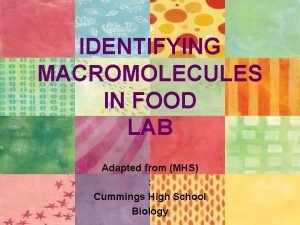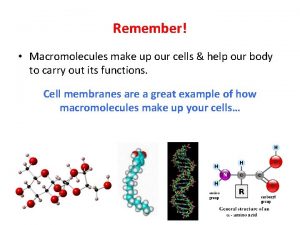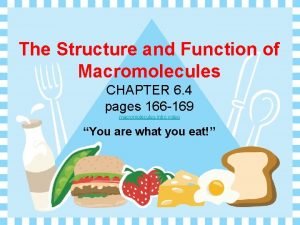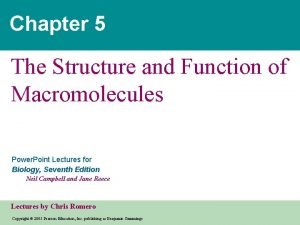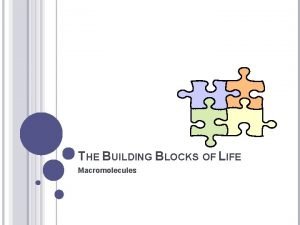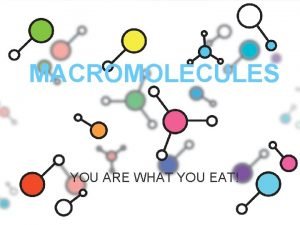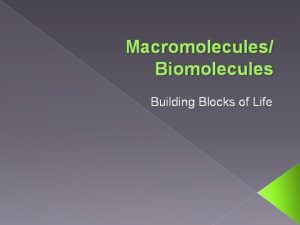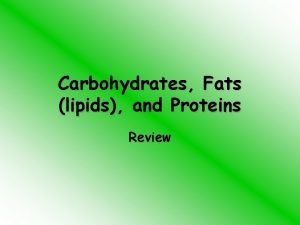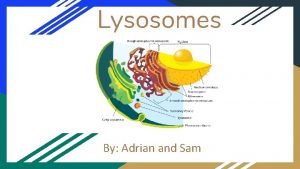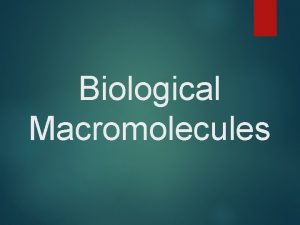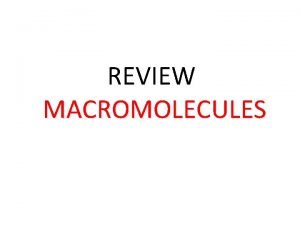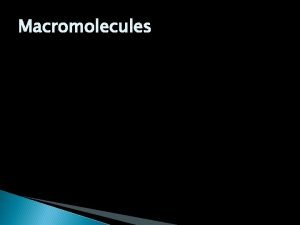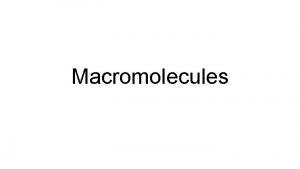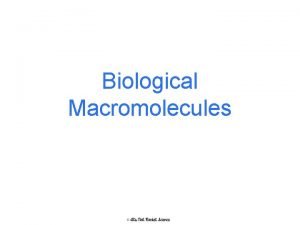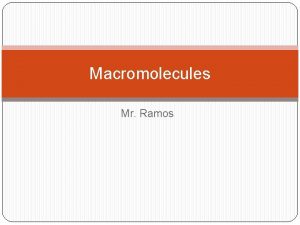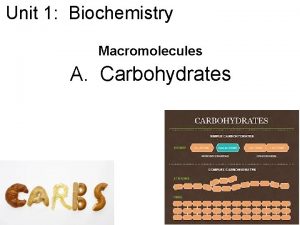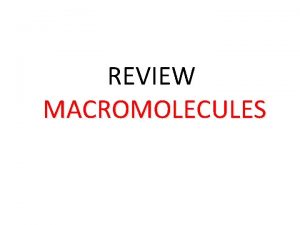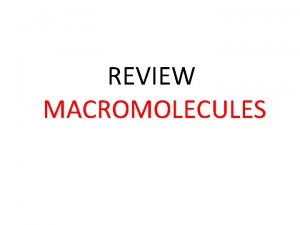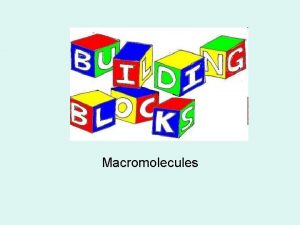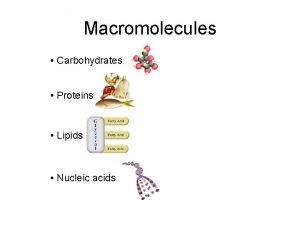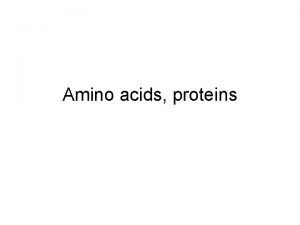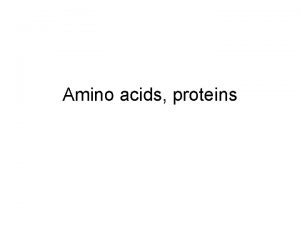MACROMOLECULES PROTEINS WHAT ARE PROTEINS Proteins are the













- Slides: 13

MACROMOLECULES PROTEINS

WHAT ARE PROTEINS? • Proteins are the most diverse molecules in living organisms. • Make up 50% of most cells EXTREMELY IMPORTANT IN LIVING THINGS! • Involved in almost everything that cells do. • Shape (Structure) is directly related to what they do (Function) STRUCTURE FUNCTION ENZYMES: Special proteins that help reactions happen in cells (more on these later)!

JUST SOME EXAMPLES OF WHY PROTEINS ARE IMPORTANT: • Structural building blocks: – Hair (karatin) – Fingernails (karatin) • Functional Molecules – Antibodies (identify and remove harmful particles from body – Immune System) – Hemoglobin (transports oxygen through body) – Protein Carriers (move substances in and out of cells) • AND SO MUCH MORE!!!!!

FROM DNA TO PROTEIN Each Gene on the DNA codes for a different polypeptide One Gene, One Polypeptide e id pt e pe l ly imp po a s tein A o s I pr is e n e A g ction e a s NA D of

FROM DNA TO PROTEIN The Genetic information in DNA codes SPECIFICALLY for production of PROTEINS and NOTHING ELSE. No Carbs! N Lip o ids !

. WHAT ARE PROTEINS MADE OF? REVIEW: 1) What is a Monomer? The building block of polymers (macromolecules) 2) What is the monomer of a Carbohydrate? A Monosaccharide A protein is a polymer made up of monomers called: 3) What are the monomers of Lipids? Glycerol and Fatty Acids Amino Acids (AAs)

AMINO ACIDS All AAs have: • • A Carboxyl Group (-COOH) An Amino Group (-NH 2) A Hydrogen Atom (-H) A Side Chain (-R) • Also called an R group We are focusing on the AAs in plants and animals. Other types of organisms have different AAs. There are 22 different R groups. Therefore, 22 different Amino Acids Essential Aas (10) • Body cannot make, so you must consume them. • meat, fish, eggs. Non-essential Aas (12) • Body can make. • Nuts, seeds, beans

THE 22 AMINO ACIDS MAIN IDEA: The R groups differ between AAs giving them different chemical properties: There are 2 AAs missing here. They were discovered relatively recently. • Acidic • Basic • Polar • Non-Polar

DNA POLYPEPTIDE Protein Synthesis. The process by which a protein is made is called DNA Contains Genes One gene tells the cell which order to put the AAs in to create a specific protein. The AAs are linked together by Peptide Bonds A chain of Amino Acids is called a Polypeptide.

LEVELS OF PROTEIN STRUCTURE • The different R groups on the AAs attract and repel each other in different ways. • This is why proteins are so varied and can fulfill so many functions. • There are four levels of protein structure, increasing in complexity, depending on how the AAs interact with each other. Primary Structure Amino Acid Sequence of a Polypeptide Secondary Structure Areas of coils and pleated sheets due to hydrogen bonding within a polypeptide Eg. Hair Tertiary Structure Quaternary Structure Overall shape of a polypeptide Eg. Hormones Shape of multiple polypeptides interacting together. Eg. Enzymes

CHANGING THE ORDER OF AAs CHANGES THE PROTEIN • If the structure of a polypeptide is changed, it will effect the function of the resulting protein. STRUCTURE FUNCTION. USING THE CODE, DECIPHER THE SENTENCES "Willfdfd Code fdfdfdfd = it = will = you = do ORIGINAL: 1) 2) 3) ________ _______ ? _______ _______ ? you do it? " "Do you will it? more: http: //www. city-data. com/forum/writing/1115620 -two-sentences-have-same • ad. In this analogy, words represent _______and the sentences represent words-but. html#ixzz 40 Sz 6 Oz 6 s"Will you do it? " __________. "Do you will it? " you change the meaning of the • If you change the order of the ______, __________. The new sentence may have a different meaning or not make sense at all. • Similarly, If the order of ______are changed, the _________ will fold up differently, resulting in a protein with a different ______ and therefore different _______, or a protein that does not work.

SICKLE CELL ANEMIA • Sickle cell anemia is a genetic disorder. • Red blood cells contain an important protein, hemoglobin. • One AA is replaced by another in the polypeptide (glutamate valine) • The change causes the red blood cell to become crescent-shaped (sickled). • Causes clots in vessels resulting in severe fatigue to death.

PROTEIN DENATURATION • When the structure of a protein is changed due to an external stress. • Stresses – – Heat Radiation Change in salt concentration Change in p. H • Stresses cause the protein to uncoil or change shape, changing its function. • Change can be temporary or permanent.
 Antigentest åre
Antigentest åre Macromolecule indicator tests
Macromolecule indicator tests Macromolecules
Macromolecules What is this?
What is this? Chapter 5 the structure and function of macromolecules
Chapter 5 the structure and function of macromolecules Macromolecules
Macromolecules You are what you eat macromolecules
You are what you eat macromolecules Carbohydrates monomer building blocks
Carbohydrates monomer building blocks What macromolecules are in bread olive oil and pasta
What macromolecules are in bread olive oil and pasta Nucleic acid indicator
Nucleic acid indicator Digestive organelle where macromolecules are hydrolyzed
Digestive organelle where macromolecules are hydrolyzed Whats macromolecules
Whats macromolecules Which macromolecule speeds up chemical reactions
Which macromolecule speeds up chemical reactions Micromolecules and macromolecules
Micromolecules and macromolecules

